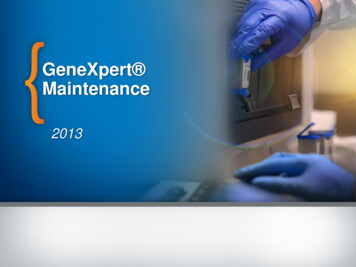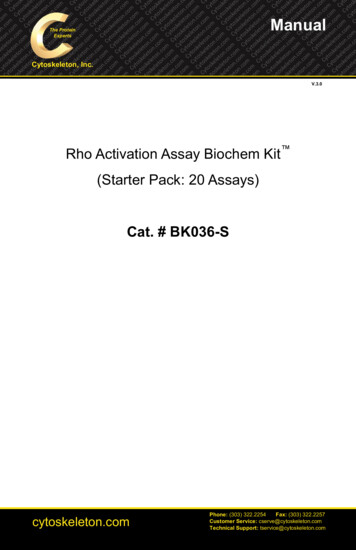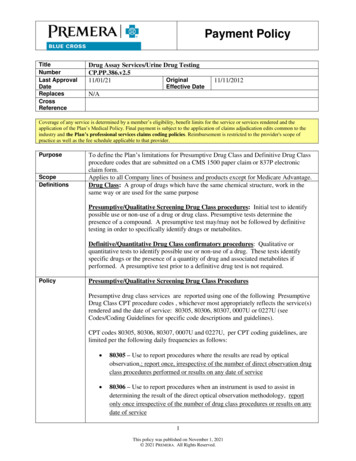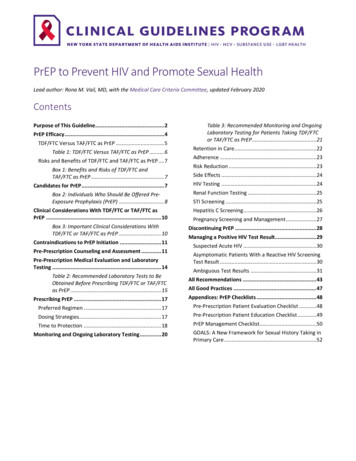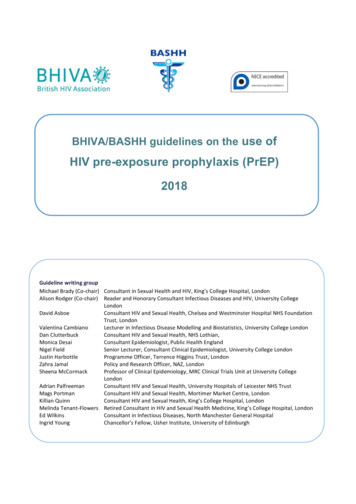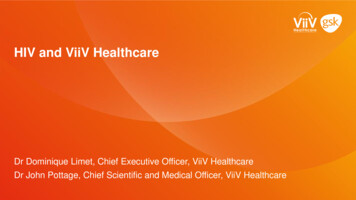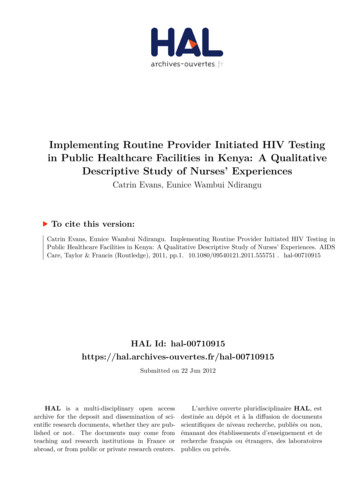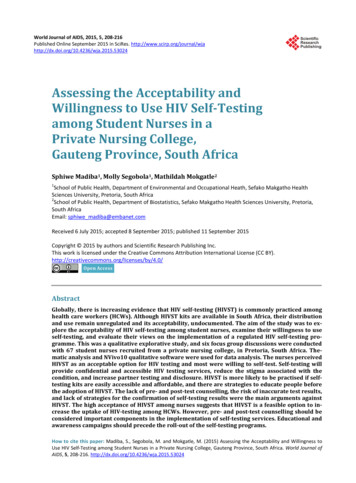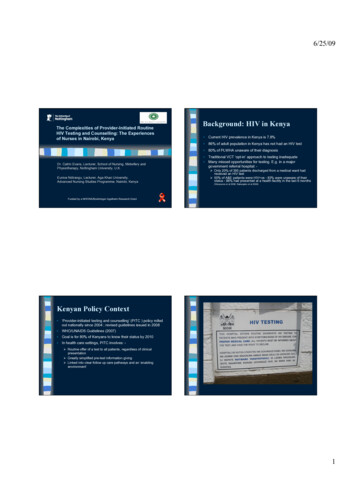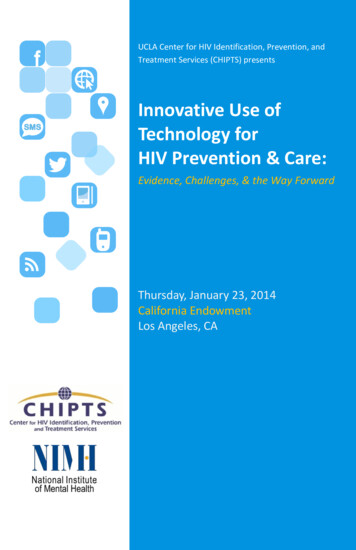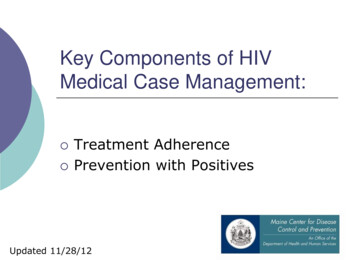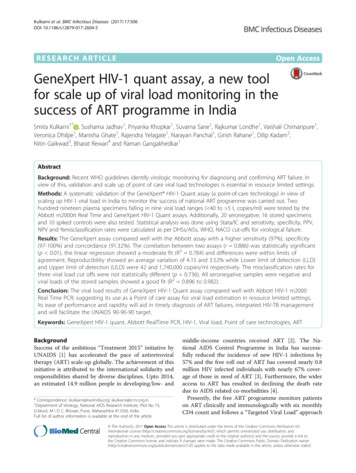
Transcription
Kulkarni et al. BMC Infectious Diseases (2017) 17:506DOI 10.1186/s12879-017-2604-5RESEARCH ARTICLEOpen AccessGeneXpert HIV-1 quant assay, a new toolfor scale up of viral load monitoring in thesuccess of ART programme in IndiaSmita Kulkarni1* , Sushama Jadhav1, Priyanka Khopkar1, Suvarna Sane1, Rajkumar Londhe1, Vaishali Chimanpure1,Veronica Dhilpe1, Manisha Ghate1, Rajendra Yelagate1, Narayan Panchal1, Girish Rahane1, Dilip Kadam2,Nitin Gaikwad3, Bharat Rewari4 and Raman Gangakhedkar1AbstractBackground: Recent WHO guidelines identify virologic monitoring for diagnosing and confirming ART failure. Inview of this, validation and scale up of point of care viral load technologies is essential in resource limited settings.Methods: A systematic validation of the GeneXpert HIV-1 Quant assay (a point-of-care technology) in view ofscaling up HIV-1 viral load in India to monitor the success of national ART programme was carried out. Twohundred nineteen plasma specimens falling in nine viral load ranges ( 40 to 5 L copies/ml) were tested by theAbbott m2000rt Real Time and GeneXpert HIV-1 Quant assays. Additionally, 20 seronegative; 16 stored specimensand 10 spiked controls were also tested. Statistical analysis was done using Stata/IC and sensitivity, specificity, PPV,NPV and %misclassification rates were calculated as per DHSs/AISs, WHO, NACO cut-offs for virological failure.Results: The GeneXpert assay compared well with the Abbott assay with a higher sensitivity (97%), specificity(97-100%) and concordance (91.32%). The correlation between two assays (r 0.886) was statistically significant(p 0.01), the linear regression showed a moderate fit (R2 0.784) and differences were within limits ofagreement. Reproducibility showed an average variation of 4.15 and 3.52% while Lower limit of detection (LLD)and Upper limit of detection (ULD) were 42 and 1,740,000 copies/ml respectively. The misclassification rates forthree viral load cut offs were not statistically different (p 0.736). All seronegative samples were negative andviral loads of the stored samples showed a good fit (R2 0.896 to 0.982).Conclusion: The viral load results of GeneXpert HIV-1 Quant assay compared well with Abbott HIV-1 m2000Real Time PCR; suggesting its use as a Point of care assay for viral load estimation in resource limited settings.Its ease of performance and rapidity will aid in timely diagnosis of ART failures, integrated HIV-TB managementand will facilitate the UNAIDS 90-90-90 target.Keywords: GeneXpert HIV-1 quant, Abbott RealTime PCR, HIV-1, Viral load, Point of care technologies, ARTBackgroundSuccess of the ambitious “Treatment 2015” initiative byUNAIDS [1] has accelerated the pace of antiretroviraltherapy (ART) scale-up globally. The achievement of thisinitiative is attributed to the international solidarity andresponsibilities shared by diverse disciplines. Upto 2014,an estimated 14.9 million people in developing/low- and* Correspondence: skulkarni@nariindia.org; skulkarni@icmr.org.in1Department of Virology, National AIDS Research Institute, Plot No 73,G-block, M I D C, Bhosari, Pune, Maharashtra 411026, IndiaFull list of author information is available at the end of the articlemiddle-income countries received ART [2]. The National AIDS Control Programme in India has successfully reduced the incidence of new HIV-1 infections by57% and the free roll out of ART has covered nearly 0.8million HIV infected individuals with nearly 67% coverage of those in need of ART [3]. Furthermore, the wideraccess to ART has resulted in declining the death ratedue to AIDS related co-morbidities [4].Presently, the free ART programme monitors patientson ART clinically and immunologically with six monthlyCD4 count and follows a “Targeted Viral Load” approach The Author(s). 2017 Open Access This article is distributed under the terms of the Creative Commons Attribution 4.0International License (http://creativecommons.org/licenses/by/4.0/), which permits unrestricted use, distribution, andreproduction in any medium, provided you give appropriate credit to the original author(s) and the source, provide a link tothe Creative Commons license, and indicate if changes were made. The Creative Commons Public Domain Dedication o/1.0/) applies to the data made available in this article, unless otherwise stated.
Kulkarni et al. BMC Infectious Diseases (2017) 17:506for treatment failure. However, several studies have demonstrated poor predictive value of the immunologicalcriteria and reported accumulation of HIV drug resistantmutations due to delayed detection of treatment failure[5–7]. To avoid this, WHO strongly recommends viralload monitoring as the preferred approach to diagnoseand confirm treatment failure [8–11].Nucleic Acid Testing (NAT) based technologies areconsidered as the gold standards for HIV-1 viral load estimation because of their high specificity, sensitivity andwide linear range of detection. However, these assays require testing to be performed by well-trained techniciansand need at least 8-10 h. With an increasing demand toscale up HIV-1 viral load monitoring, a robust, easy touse and sensitive point-of-care technology (POC) [12] isutmost essential. Numbers of POC viral load assays arein the development pipeline [13, 14] and GeneXpert HIV-1 Quant Assay (Cepheid Innovations Pvt. Ltd., USA)is one of the recently introduced assays. It is a fully automated integrated system that is routinely used for detecting M. tuberculosis DNA and resistance to Rifampicin [15,16] as well as other pathogens (MRSA, Norovirus, HBV,HPV [17–21]) including HIV. It is a rapid assay that delivers results within 90 mins. It uses reverse transcriptasepolymerase chain reaction (RT-PCR) technology toachieve high sensitivity over the range of 40 to 10,000,000copies/ml (1.6 to 7 log10copies/ml) and can quantitate allHIV-1 Group M, N and O subtypes [22]. Furthermore, areduced turnaround time leads to prompt HIV diagnosisand clinical management in adult and pediatric samples.Apart from this, the assay is very simple and safe to perform; their integrated reagents and consumables are robust in usage and can be stored in refrigerators. Due tominimal requirement of infrastructure, it is very easy toscale up the activity of viral load testing nationally. Considering all these features, the Gene Xpert HIV-1 Quantassay serves as a valuable point of care viral load assay thatcould be useful for monitoring antiretroviral therapy aswell as integrated HIV-TB management in developingcountries like India [23]. Therefore in the present study,we compared performance of GeneXpert HIV-1 QuantAssay with the gold standard, routinely used Abbottm2000rt RealTime HIV-1 (Abbott Molecular, Germany)in the resource limited Indian settings in view of the scaleup of viral load testing [24]. The performance evaluationof this new assay will ensure its decentralized utility in theclinical set up and will assist in management of patientcare efficiently.MethodsStudy designA systematic validation of the GeneXpert HIV-1 Quantassay (a point-of-care technology) in view of scaling upPage 2 of 9HIV-1 viral load in India to monitor the success of national ART programme was carried out.Ethics statementThe study was approved by the 59th National AIDS Research Institute (NARI) Ethics Committee (ApprovalNo: NARI/EC Protocol No. 2015-10). All study participants provided a written informed consent for collectingdemographic information, plasma viral load testing andretention of plasma samples.Study setting and specimen collectionThe study was conducted from June to September 2015in HIV-1 positive adult individuals. 314 HIV-1 seropositive(ART naïve n 151, On ART n 129, suspected ART failure n 34; individuals were screened to obtain varyingviral load ranges) and 20 normal healthy HIV seronegativeindividuals were enrolled at three ART centers located inPune (ART centres: Model Colony; YCM Hospital; Sassoon General Hospital).The whole blood specimens werecollected in 10 ml EDTA vacutainers (Becton Dickinson,USA), transported to NARI, centrifuged at 405 g for 10mins, plasma was separated within 6 h, aliquoted andstored at 70 C until tested.Viral load estimationFollowing manufacturers’ instructions, all plasma specimens were tested by an automated Abbott m2000rt RealTime HIV-1 assay (Abbott Molecular Inc., Germany)within 2 days of collection in batches of 24 and resultswere expressed as copies/ml [25–27].Of 314, 219 specimens falling in nine viral load ranges(Table 1) were selected and tested by the HIV-1 Quantassay following the manufacturer’s instructions within 3days after sample collection. Briefly, the assay was carried out by adding 1.2 mL of plasma to the cartridgeswhich contain reagents for RNA extraction, reverse transcription and real-time cDNA quantification based onthe conserved region of 3′-LTR of HIV-1.Additionally,following sets 1) spiked copy controls (prepared by spiking the normal human plasma (NHP) with pooled highHIV-1 viral load plasma [n 25, 20 - 20, 00,000 copies/ml]and HIV-1 viral culture supernatant (n 25, 40 - 40,00,000 copies/ml) and 2) samples stored at three timepoints (1, 2 and 3 months) were used.Statistical analysisThe viral load values (copies/mL) were transformed tolog10 copies/mL and the statistical analysis was performed using Stata/IC 10.1 for Windows (Copyright 1984-2009). The percent concordance among the nineviral load ranges was determined and reproducibility, inter- and intra-assay variation were studied using coefficient of variation. The Bland-Altman plot was generated
Kulkarni et al. BMC Infectious Diseases (2017) 17:506Page 3 of 9Table 1 Viral load ranges selected for validationby Abbott m2000 Real Time PCR and GeneXpert HIV-1Quant assays.Viral Load rangesSpecimens tested byAbbott Real Time HIV-1Specimens tested byGeneXpert HIV-1 QuantNot detected8527 40202440 -2002415201 -250024162501 -500021165001 -10,000231910,001 -1 L5959100,001 -5 L4526 5L1317Total314219to assess the limits of agreement and mean bias (95% CI).The descriptive statistical tests were used to compare themisclassifications rates for different viral load cut-offs asper two internationals viz. [Demographic Health Surveys/AIDS Indicator Surveys (DHSs)/AISs) cut-off 200 copies/ml [28] and WHO cut-off 400 copies/ml] [29] and one national cut-off [NACO cut-off 1000 copies/ml] [30] usedfor classifying the treatment failures. The coefficient of determination (R2) was used to assess the linear fit for pairedreadings of log viral load copies by two methods. Additionally, the lower and upper limits of detection (LLD andULD) were calculated using minimum and maximumvalues. The uncertainty limits for natural variation inGeneXpert viral load results were also calculated.ResultsThe paired plasma specimens collected from 219 studyparticipants (mean age 37.6 years, SD 9.4) were testedConcordance between Abbott and HIV-1 quant assaysThe percentage of concordant samples in both the assaysis depicted in Fig. 1 and Table 2. Out of 175 samples detected by the Abbott assay, 8 samples (range: 42-92 copies/mL) were undetectable (false undetected) by theGeneXpert assay. Also, one of the 44 samples undetectable by the Abbott assay, was detectable (42 copies/mL,false detected) in the GeneXpert assay.The concordance was determined by measuring thepercentage of samples containing 40 or 40 copies/mlwhich was 91.32% (200/219 samples). Table 2 shows detailed analysis of the concordance obtained between thetwo assays. The percent concordance between each ofthe seven quantifiable categories (40- 5 L copies/mL)ranged from 82-100%. Out of 167 samples quantifiable bythe GeneXpert assay, 86.8% (145/167) of the samples werefitting within the acceptable limit ( / 0.5 log copies/mL)whereas 13.2% (22/167) were outside this limit. Furtheranalysis of 167 quantifiable samples for studying the correlation between two assays indicated a statistically significant(p 0.01) Pearson’s correlation coefficient (r 0.886).Correlation and bland-Altman analysisThe scatter plot indicated a moderate fit with coefficientof determination: R2 0.784 (Fig. 2). Further, the level ofagreement studied using the Bland-Altman plots indicated that the differences were within the limits ofagreement ( 0.909 to 1.15). No systematic trend was observed from lower to higher values. The mean bias waspositive showing an overestimation by the HIV-1 Quantassay with an average bias of 0.120 and 95% CI (0.042 toFig. 1 Flow Chart of specimens selected for the validation of GeneXpert HIV-1 Quant
Kulkarni et al. BMC Infectious Diseases (2017) 17:506Page 4 of 9Table 2 Concordance in different viral load categories of Abbott Real Time HIV-1 and GeneXpert HIV-1 Quant* Lakhs0.199) (n 167) (Fig. 3). Overall, results indicated astrong agreement between results of the two assays.Sensitivity, specificity, PPV, NPV and percentmisclassificationThe misclassification data refers to reporting a “Not detected” viral load result as “detected” and vice versa.Considering the implementation of the validated assayon a larger scale, the data was analyzed in view of threecut-offs, DHSs/AIS; WHO and NACO that consider200, 400 and 1000 copies/ml respectively, which indicatedthat the sensitivity remained constant (97%) for the threecutoffs while the specificity differed (100, 97 and 98% respectively). The PPV was 100% for the DHS cut off; 99%for WHO and NACO while the NPV showed an increasing trend (88, 89, 91% respectively) (Table 3). The lowestmisclassification rate (2.14%) was observed for the cut-off200 with 95% CI (0.6%, 5.4%). Overall, the percent misclassification rates for the three cut offs were not statistically different when compared by the proportion test(p 0.736).ULD, LLD, reproducibility analysis and uncertainty limitsfor the natural variationThe viral load results for 10 paired specimens (with 3 repeat tests) were selected from inter-assay and reproducibility analyses was carried out. The Bland-Altman analysisshowed mean difference (max among all) of 0.064 log10copies/ml (95% CI: -0.170, 0.042); which is much lesserthan the acceptable limit of 0.5 log10 copies/ml. The LLDand ULD for GeneXpert system were 1.62 log10 copies/ml. (42 copies/ml) and 6.24 log10 copies/ml (1,740,000copies/ml) respectively.Precision analysis on spiked copy controlsThe inter- and intra-assay variation assessed using copycontrols spiked with pooled HIV-1 viral load plasma indicated variation in the GeneXpert assay as 1.42% (range0.36–2.74%) and 1.24% (range 0.31–3.34%) respectivelyacross the range of viral load copies (20–20 L copies/ml)(Table 4).Additionally, inter- and intra-assay variation assessedusing copy controls spiked with HIV-1 viral culturesupernatant indicated variation in the GeneXpert assayas 4.15% (range 0.78–6.96%) and 3.52% (range 0.78–10.66%) respectively across the range of viral load copies(40 – 40 L copies/ml) (Table 4).Carryover analysisFig. 2 Scatter plot of plasma viral load of Abbott Real Time HIV-1and GeneXpert HIV-1 QuantThe possibility of carry-over contamination was verifiedby placing the 20 seronegative sample before or after theseropositive samples. The results indicated that all
Kulkarni et al. BMC Infectious Diseases (2017) 17:506Page 5 of 9Fig. 3 Bland-Altman plot for Abbott Real Time HIV-1 and GeneXpert HIV-1 Quant assay resultsseronegative samples were negative without any carryover, indicating 100% specificity of the GeneXpert assay.(Data not shown).Linear regression analysis of viral load on stored plasmasamplesThe linear regression analysis of the samples stored for1, 2 and 3 months showed a good fit with no significantdifference in the regression coefficient [R2 0.920; 0.896and 0.982 respectively] (Fig. 4).DiscussionNAT based real-time quantitative PCR’s are the preferredoptions for high-throughput HIV-1 viral-load testing indeveloped and developing countries [31]. However, theseassays are time consuming and flow separately throughthree steps - sample preparation, amplification, detectionand require specimen transportation, high-end instrumentation, skilled personnel, and dedicated laboratories [22].Hence as suggested by the recent WHO guidelines [11]and to generate results with “sample-in/answer-out”Table 3 Data on sensitivity, specificity, PPV, NPV & %misclassification as per national and international cut-offsCut-offs classifying treatmentfailuressensitivity, specificity, PPV, NPV &% misclassificationDHSs and AISs cut-off( 200 copies/ml)Sensitivity 97%, specificity 100%,PPV 100%, NPV 88%% misclassification (95%CI) 2.14%(0.6%, 5.4%)WHO cut-off( 400 copies/ml)Sensitivity 97%, specificity 97%,PPV 99%, NPV 89%% misclassification (95%CI) 2.67%(0.9%, 6.1%)NACO cut-off( 1000 copies/ml)Sensitivity 97%, specificity 98%,PPV 99%, NPV 91%% misclassification (95%CI) 2.67%(0.9%, 6.1%)approach [32], replacing NAT based assays with partially/fully automated POC assays is crucial.The National ART programme in India was launchedin April 2004 in limited number of hospitals. Subsequently,concentrated efforts resulted in expansion of theprogramme. Currently, the programme has adopted apublic health approach for provision of ART & providescomprehensive prevention, care and treatment services,with a standardized and simplified combination of ARTregimen free of cost to more than 8.8 lakhs PLHIVsacross 528 ART centers and 1080 Link ART centersacross the country which is a second highest number inthe world. Wider access to ART has led to 29% reduction in estimated annual AIDS related deaths [33].However, the success of high-quality ART depends ontimely monitoring of viral load and confirmation of ARTfailure. Introduction of a simple and reliable POC viralload assay will deliver ART service more appropriatelyand significantly in a decentralized manner. This will potentially reduce the cost of transportation of samplesand monitoring patients on antiretroviral therapy without compromising the quality of care required for treatment success. The “ASSURED” criteria set by WHOdescribes the POC assays as affordable, sensitive, specific, user-friendly, robust/rapid, equipment-free, and deliverable techniques. Many such POC technologies [13]are in development and GeneXpert HIV-1 Quant assayis one of them. The system requires single-use disposable GeneXpert cartridge that are self-contained andcould be useful for viral load monitoring in resourcelimited settings. As the patient load in Indian ART centers is low and variable, the viral load testing requirement can be low every day in smaller in district ARTcenters. Such small number of viral load tests are manageable with POC GeneXpert platform [33] In certaindistricts because the RNTCP, some GeneXpert POC
Kulkarni et al. BMC Infectious Diseases (2017) 17:506Page 6 of 9Table 4 Inter and Intra Assay Variation between Abbott Real Time HIV-1 and GeneXpert HIV-1 QuantNHP spiked with high VL plasmaHIV-1 viral load(copies/ml)NHP spiked with viral stockCoefficient of variation (% CV)Inter-AssayHIV-1 viral icient of variation (% .580.780.4540,00,0000.690.780.330.78machines for TB diagnosis have already been placed [34]The load of TB testing along with viral load estimationon the same instrument is possible. Hence, convergenceof both the program’s is possible through integratedtesting.Our results indicated that HIV-1 Quant assay comparedwell with the Abbott plasma viral load assay [27, 32]. Thehigh percentages of concordance (91.32%), correlation(r 0.886) and minimum differences in the mean viralloads (0.12 log copies/ml, as measured by Bland-Altmananalysis) were
GeneXpert HIV-1 quant assay, a new tool for scale up of viral load monitoring in the success of ART programme in India Smita Kulkarni1*, Sushama Jadhav1, . Kulkarni et al. BMC Infectious Diseases (2017) 17:506 Page 2 of 9.
